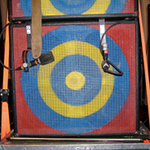Kensuke Koike
Aliens’ Lounge
Virgil de Voldère Gallery
526 West 26th Street, Room 416, New York, NY
December 11, 2009–February 12, 2010
In his New York solo debut at Virgil de Voldère, Kensuke Koike, a Japanese artist based in Italy, presents several works of photographic collage and stop-motion video that reveal a sense of wonder and imagination teased from the seemingly factual nature of photography. With these works Koike presents a highly personal vision of reality and representation in which he proposes new ways of seeing, and how we can have fun with them.
Multifaceted views and simultaneity have been hallmarks of twentieth-century art since Cubism, and more recently artists like David Hockney, Christian Marclay, and John Stetzaker have explored collage in various genres, including portraiture and landscapes, with original and found images. What makes Koike’s work distinctive is that he doesn’t aim to present precise, psychologically charged examinations of his subjects or, more generally, about the nature of visual art, as many artists have done before. His goal is more open ended: “Collage,” he says, “is the best method to seek what I have always loved: magic, mystery, and coincidence.”
The artist’s previous solo exhibition, held earlier this year at Perugi artecontemporanea in Padua, Italy, explored representations of mythic Japanese demons, called Yokai, through complex arrangements of photographs of his body. For the new work at Virgil de Voldère, he again uses his self-image, intricately collaging dozens of individual photographs, this time in a gridlike rectangle on the wall. Startling in its four-by-six-meter size, the collage He won't amount to much! brings to mind fearsome movie creatures, like the alien in Ridley Scott’s 1979 film. Similarly, the monsters in the looped videos, How 'bout a date? and I’m not what you think, are also based on photographs of the artist’s own body. They leap and flail and crawl, but these creatures don’t quite feel terrifying or grotesque. Avoiding the kind of computer-generated imagery used in contemporary film, Koike’s photographs provide a “low-resolution” experience that paradoxically is richer and more complex.
Several collage portraits depict the artist’s friends. Whatever their identities are in real life, in the artist’s hands they become fantastical images that offer us an alternative way to envision our fellow humans—with double heads and multiple bodies and limbs—as we cannot, physically, in everyday life. In addition to astute composition, Koike pays close attention to color, contrasting the ordinary skin tones of his subjects with glorious color-saturated backgrounds that recall luminous Italian Renaissance painting of his adopted country.
Koike uses film and video precisely for their qualities of realism and representation, but through his canny, incisive use of collage he also seizes the ability to undermine the apparent seamlessness of those mediums. This work nudges us to awake from the perceptual slumber of taking photographic appearances at face value, while at the same time encouraging us to dream, to question why the border between reality and imagination exists the way it does, and how we can picture these two opposing poles anew.
